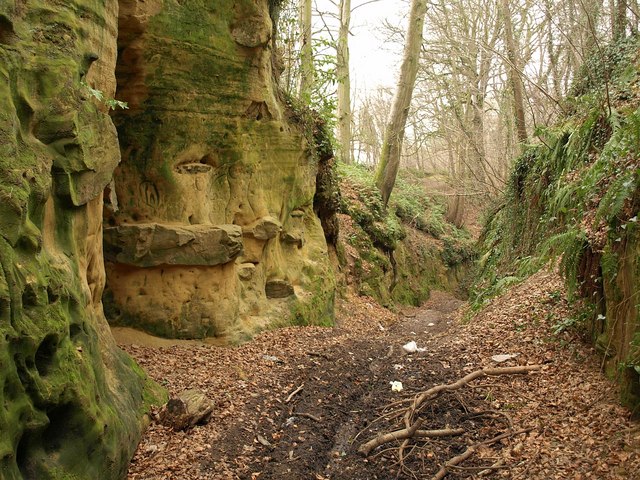The word “holloways” is derived from the Anglo-Saxon term “hola weg,” meaning ”harrowed path,” or “sunken road.” While the ancient Oregon Trail, which was used by thousands of pioneers heading west through North America, has many sunken roads; they developed over the course of only a couple of decades. The old roadways across Europe, however, are between 300 and 3,000 years old, with some dating back to Roman times or even earlier.
The ancient holloways are both a little-known gem and a well-kept secret in the ancient settlement of Dorset, a rural English county along England’s only World Heritage Site, Jurassic Coast. Both Thomas Hardy, whose novels were set in the surroundings, and William Barnes, whose poetry extols the virtues of the traditional Dorset dialect, were born in Dorset. In his book The Making of the English Landscape, English historian W. G. Hoskins explains how the holloways came to be. According to Hoskins, some holloways are Celtic, Saxon, or Medieval.
Drovers of cattle, wagons, and pilgrims traveled primitive woodland routes that meandered extensively to and fro over the land from the coast. They went north through the recessed thoroughfares of Dorset, which cut through the countryside. They led inland into the Jurassic Lias, where the Permian sandstones and mudstones, the oolites, and the soft chalks of the region are found.
These winding roads cut deep into the dense woodlands between farms and markets in the countryside and along the coast. Over the long passage of time, the wheels of wagons moving cargo to and from ships docked in the ports, along with horse hooves, and human feet carved ruts into the exposed stone surface. Heavy rainfalls and bad weather further eroded the roads, and the soft soil underneath gradually sunk. Some roads measured 20 or 30 feet below ground level on each side.

Emerald Pathways
Two of Britain’s finest sunken lanes link Symondsbury with North Chideock, Shute’s Lane, and Hell Lane in West Dorset. Hell Lane is a 300-year-old holloway known as the famed “Smuggler’s Road.” While walking along this intriguing track, one may be surprised by hidden sculptured faces or a giant eye skillfully carved into the rock. Some parts have an aesthetically Tolkienesque atmosphere with the pleasing overgrown shutes lined with tall trees that create an almost fairytale-like awning.
Success
You are now signed up for our newsletter
Success
Check your email to complete sign up
Over massive exposed roots of ancient mystical Ash trees, ivy trails twist among bushes and dense vegetation, while the endless emerald leaf canopies encourage the growth of lichens and mosses on dark velvety barks. Cranesbill geranium, Hart’s-tongue fern, and many other species thrive here. It’s not uncommon to come upon wood pigeons, mushrooms, rabbit tunnels, badger encampments, and fox holes.
Nestled in the most intensively cultivated land on earth, the holloways have evolved into a subterranean labyrinth of wilderness. Gilbert White, the pioneering naturalist from the 18th century, made a typically careful study of the holloways in his Natural History of Selborne (1788), where he said, “access a world of deep history, an unexpectedly wild world, buried amid the familiar and close at hand.”

White visited the holloways when the temperature in Selborne dropped to -3 or -4 degrees Celsius and noted that the leaves of laurel bushes were scorched brown by the cold. He observed the snow falling thick enough to fill the holloways and becoming sculpted by the wind into shapes “so striking to the imagination, as not to be seen without wonder and pleasure, and when the sun shines in the winter, reflected sunlight from the snow is bright enough to dazzle animals and birds.”
Most holloways are too deep to be farmed over and many are too narrow to walk. The walls of nettles, briars and ivy make them almost impenetrable. Others are relatively shallow, perhaps because the harder rock was near the surface. Native English bluebells line the woodland paths in season.
England has a rich creative legacy of the “unseen landscape.” Artists have seen visions in ditches and discovered the infinite in the finite. William Blake saw “a world in a grain of sand.” John Ruskin, the English author and art critic who championed the Pre-Raphaelites, was mesmerized by the proliferation of lichens and mosses on tree trunks and rocks.

These ancient pathways through worn cantons, followed the ’lay of the land,’ skirting around woods, valleys, and hills, and along the winding courses of streams and rivers, existing in harmony with the surroundings.
Today, bypasses, roads and vehicles slash through ancient forests and slopes, abandoning this accord between path and landform.
Nature and travel writer Robert Macfarlane, well-known for his books on natural landscapes and people, along with artist Stanley Donwood and fellow writer Dan Richards, set out to explore the sunken lanes or holloways of South Dorset’s sandstone. Together they built their own printing press to produce a book on a 1955 monotype caster, which uses brass dies to impress the type forms on the molten lead.

In his book, The Old Ways, he describes how walking the trails becomes mental and emotional passageways imprinted into our memory, much like how holloways are a fundamental element of the countryside’s character.
Casual hikers only seldom visit the old forests and foot traffic has declined, enabling nature to reclaim the landscape once again.
Geoffrey Household, the prolific British author, wrote concerning one such Holloway in his novel Rogue Male about the hero being in a Holloway so abandoned and overgrown that only curious youngsters would venture in. It may be easy to imagine that, as foot-fall becomes silent and nature takes over, the tangled roots that lie 18 feet below the surface of the fields give the old roads a strange and wild appearance.
These rugged gloomy scenes affright the ladies when they peep down into them from the paths above.
Gilbert White, The Natural History of Selborne, 1788













